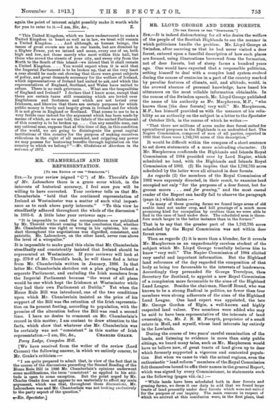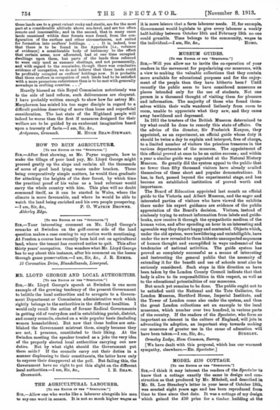MR. LLOYD GEORGE AND DEER FORESTS.
[To THE EDITOR OF THE " SPECTATOR."] SIR,—It is indeed disheartening for all who desire the welfare of the people of the Scottish Highlands to see the manner in which politicians handle the problem. Mr. Lloyd George at Swindon, after assuring us that he had never visited a deer forest, entered upon a fanciful description of bow such places are formed, using illustrations borrowed from the formation, not of deer forests, but of sheep farms a hundred years ago. One would have expected that a responsible politician, setting himself to deal with a complex land system evolved during the course of centuries in a part of the country marked by peculiar features of climate, soil, and altitude, would, in the avowed absence of personal knowledge, have based his utterances on the most reliable information obtainable. In the course of the Swindon speech, Mr. Lloyd George published the name of his authority as Mr. Macpherson, M.P., " who knows them [the deer forests] very well." Mr. Macpherson, M.P., has himself provided us with the measure of his reliability as an authority on the subject in a letter to the Spectator of October 25th, in the course of which he writes :—
" That there are millions of acres under deer forest suited for agricultural purposes in the Highlands is an undoubted fact. The Napier Commission, composed of men of all parties, reported in 1892 that there were 1,782,785 acres of this description." It would be difficult within the compass of a short sentence to set down statements of a more misleading character. (1) Mr. Macpherson confounds the Highlands and Islands Royal Commission of 1884 presided over by Lord Napier, which
scheduled no land, with the Highlands and Islands Royal Commission of 1892. (2) He implies that the 1,782,785 acres scheduled by the latter were all situated in deer forests. As regards (2) the members of the Royal Commission of 1892 were expressly directed, in their remit, to examine land occupied not only "for the purposes of a deer forest, but for grouse moors . . . and for grazing," and the most casual reader of the Report can hardly fail to observe the paragraph (page ix.) which states :—
"In many of these grazing farms we found large areas of old arable land not under crop, mad hill grazings of a much more promising kind for occupation by crofters than we were able to find in the case of land under deer. The scheduled area is therefore much larger in the latter instance than in the former."
That is to say that the greater part of the 1,782,785 acres scheduled by the Royal Commission was not within deer forest areas. Then as regards (1) it is more than a blunder, for it reveals Mr. Macpherson as an unpardonably careless student of the subject which Mr. Lloyd George trustfully believes him to know "very well." The Napier Commission of 1884 elicited very useful and important information. But the Highland land reformers of the day regarded the composition of that body as being too favourable to the interests of landowners. Accordingly they persuaded Sir George Trevelyan, then Secretary for Scotland, to appoint a new Royal Commission of a complexion more favourable to the aims of the Highland Land League. Besides the chairman, Sheriff Brand, who was known to be a strong Radical in politics, no fewer than four members were strong adherents of the aims of the Highland Land League. One land expert was appointed, the late Mr. George Gordon of Elgin, a well-known and highly respected land valuer. Two members were added who may be said to have been representative of the interests of land ownership, viz., Mr. J. N. M. Forsyth, proprietor of a small
estate in Mull, and myself, whose land interests lay entirely in the Lowlands. During the course of two years' careful examination of the lands, and listening to evidence in more than sixty public sittings, we beard many tales, such as Mr. Macpherson would have us believe now, of great tracts of land given up to deer which formerly supported a vigorous and contented populationBut when we came to visit the actual regions, even the enthusiastic "land reform" members of the Royal Commission felt themselves bound to affix their names in the general Report, which was signed by every Commissioner, to statements such as the following (pages viii.-ix.) :— " While lands have been scheduled both in deer forests and grazing farms, we deem it our duty to add that we found large tracts of land presently under deer forests which were not suited for the purpose of our inquiry. The main reasons in respect of which we arrived at this conclusion were, in the first place, that
these lands are to a great extent rocky and sterile, are for the most part at a considerable altitude above sea-level, and are too often remote and inaccessible ; and in the second, that in many cases lands examined within deer forests were found, from the configuration of the surface and other circumstances, not suited for formation into crofters' holdings. . . . It is, indeed, true that there is to be found in the Appendix [i.e., volumes of evidence] a considerable body of testimony to the effect that certain areas, now afforested, had at one time occupied dwellings upon them, but parts of the lands thus referred to were only used as summer sheilings, and not permanently, and with regard to the remainder, though there was conclusive evidence of occupation, we do not believe that these lands could be profitably occupied as crofters' holdings now. It is probable that those crofters in occupation of such lands had to be satisfied with a more precarious subsistence than is to be met with generally nowadays in crofting counties. . . ." Heavily biassed as this Royal Commission notoriously was to the side of land reform, such deliverances are eloquent. I have probably written enough to show how far astray Mr. Macpherson has misled his too eager disciple in regard to a difficult problem deserving of more than loose and superficial consideration. The last state of the Highland people will indeed be worse than the first if measures designed for their welfare are to be guided by an exuberant imagination based upon a travesty of facts.—I am, Sir, &c.,
Ardgawan, Greenock. M. HUGH SHAW-STEWART.



















































 Previous page
Previous page